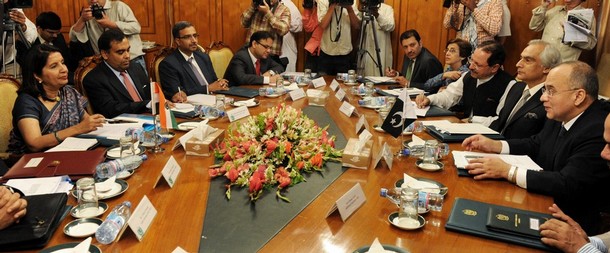
Pakistan’s deceit in cocooning Osama bin Laden in Abottabad as well as the ISI support to the Mumbai attackers has angered Indian public opinion. Unfortunately, Pakistan is a geographical reality and it will always be a neighbour. Punishing Pakistan by not engaging it in areas of our national interest is therefore not wise. Given this, the meeting between the foreign secretaries of both countries in Islamabad on June 23 is a crucial forward step.
After the previous meeting between them in Thimphu in February, the Indian external affairs ministry had directed the foreign secretary to resume talks on the same eight well-known subjects as before. In the meanwhile, Track II talks have progressed so well on nuclear confidence building measures (CBMs) that a Track I discussion on the subject could bear fruit immediately, kick-starting the entire process. Secondly, Afghanistan’s outcome hangs threateningly over the entire relationship, and the eight subjects referred to do not include an understanding on Afghanistan. Here again, the forward thinking Track II dialogue has cleared a path for Track I.
When India and Pakistan weaponised in 1998, they had a humble vision of what their arsenals would look like, both countries forswearing the Cold War example. Thirteen years later, there is every indication that beyond the core arsenals are quite a few weapon systems that are either useless or systems that will destabilise deterrence at low levels. In their haste to induct any delivery system, India and Pakistan acquired short-range missiles that today are obsolete and are probably being used as monstrously expensive artillery with conventional warheads. These include the Pakistani Ghazhnavi and Abdali, and on the Indian side, the Prithvi I. Nuclear experts from both countries have agreed in Track II talks that these missiles confuse the perception of the other side and, if withdrawn, would strengthen deterrence considerably at low levels.
Then again, India feels that the induction of the Babur I, the long-range cruise missile with a small circular error probability, and the new Hatf IX will induce Pakistan to abandon its declared doctrine of minimum credible deterrence, and opt for counter force. The Pakistanis have pointed to any number of threats from the Indian side based on the imminence of the Indian Ballistic Missile Defence. If this were to occur as declared by the DRDO, Pakistan’s deterrence would degrade and hence the need for a cruise missile.
This issue is too complex to take up immediately without going through the process of establishing crisis stability. Since we have already had two full alerts under the nuclear overhang, in 1999 and 2002, nuclear CBMs cannot wait for too long. Some sample ones have been discussed at Track II forums and are amenable to being transferred to Track I. These include the adoption of a common vocabulary and a Nuclear Risk Reduction Centre. Indian apprehensions about the Chinese arsenal are all the more reason for coming to an agreement with Pakistan in the first instance.
As for the other major issue, discussions on Afghanistan revealed the depth of Pakistan’s suspicions and anxieties. India, it was alleged, was engaged in destabilising their country with Indian consulates assisting dissident groups like the Baloch separatists. By creating a second front, India was using "covertisation" – i.e. bringing in military and security personnel under the cover of development projects – and was acting as a ‘spoiler’ in Afghanistan. The charges flew thick and fast, but as the discussions proceeded, voices emerged from within the Pakistani group urging their colleagues to stop demonising India and recognise that it also has legitimate interests in Afghanistan.
The most recent meeting of the Ottawa dialogue held in Istanbul saw a more accommodating Pakistan position. It has vital strategic interests in Afghanistan derived from historical-cultural-ethnic linkages and was not prepared to open a permanent front on its western border. A former senior military officer explained that Afghanistan was for Pakistan what Nepal signified for India. Pakistan, nevertheless, did not claim an exclusive or dominant status in Afghan affairs. The concept of ‘strategic depth’ was decisively rejected.
India’s strategic interests in Afghanistan and Central Asia are equally legitimate and should be recognised. It is time for Afghan issues to be discussed in official meetings so that each country does not overstate its interests and can hence avoid the other’s red lines. To placate Indian anxieties, the Taliban leadership, according to them, no longer seeks a return to a pre-9/11, Sharia-based regime; it would respect the rights of women. They were also willing to terminate their links with al-Qaida and evict foreign militant groups from the country and not interfere in the internal affairs of other countries. According to our Pakistani colleagues, it would be possible to reach agreement on the following: after the withdrawal of foreign troops, Afghanistan would require a transitional peace-keeping force to be drawn from friendly Muslim countries like Indonesia and Malaysia. And secondly, a regional contact group would facilitate Afghanistan’s political transition. The members would be inter alia India, Pakistan, Iran, Turkey, Saudi Arabia, Russia, China, and the Central Asian republics.
Agreement on Afghanistan is possible and could lead to a joint approach provided India makes clear its own vision of the endgame after 2014 – and can assure the Pakistanis that it has no interests beyond traditional friendship and communication linkages.
Admiral Raja Menon is a former career officer and submarine specialist in the Indian Navy, and currently a distinguished fellow in the Institute of Peace and Conflict Studies and the National Maritime Foundation. Lalit Mansingh is former Indian foreign secretary and Ambassador of India to the U.S. This essay originally appeared in the Times of India. Photo credit: Reuters Pictures.
Image: bashirrao.jpg
